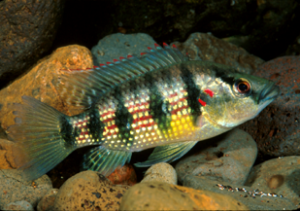Banded Jewel Cichlid
Banded Jewel Cichlid (Hemichromis elongatus)
Description:
- Fish with bronze scales and five dark bands running down the side (Froese & Pauly, 2017)
- Bands not obvious on large males (Froese & Pauly, 2017)
- Magenta spot on gill cover (Froese & Pauly, 2017)
Habitat:
- Freshwater fish typically found in shallow lakes and streams (Nico, 2021)
Impacts & Concern:
- Causes decline of indigenous fish species due to reduction in food sources and alteration of habitat (USFWS, 2018)
- Aggressive predator that feeds on small fish, insects, and shrimps (USFWS, 2018)
Introduction:
- Most likely introduced to Hawaiʻi through aquarium release (USFWS, 2018)
- First observed on Oʻahu in 1990 and is considered established (Nico, 2021)
Distribution in Hawaii:
- Kauai: Not documented
- Oʻahu: Present (Nico, 2021)
- Molokai: Not documented
- Lanai: Not documented
- Maui: Not documented
- Big Island: Not documented
References:
- Nico, L. (2021) Hemichromis elongatus (Guichenot in Duméril, 1861): U.S. Geological Survey, Nonindigenous Aquatic Species Database. https://nas.er.usgs.gov/queries/FactSheet.aspx?SpeciesID=456
- Froese, R., Pauly, D. (2017) Hemichromis elongatus (Guichenot, 1861). FishBase. https://www.fishbase.us/summary/Hemichromis-elongatus.html.
- USFWS. (2018). Banded Jewel Cichlid Ecological Risk Screening Summary. US Fish and Wildlife Service. https://www.fws.gov/fisheries/ans/erss/uncertainrisk/ERSS-Hemichromis-elongatus-FINAL-August2018.pdf.

